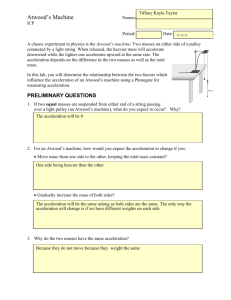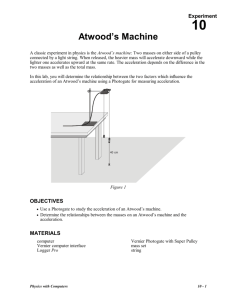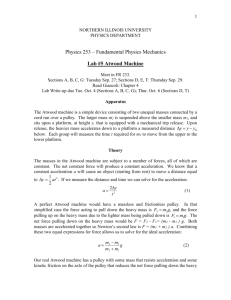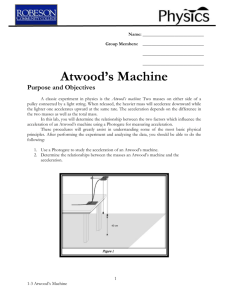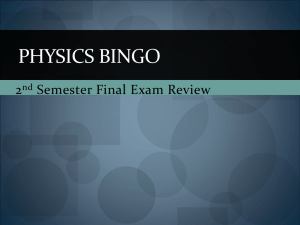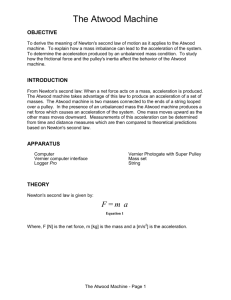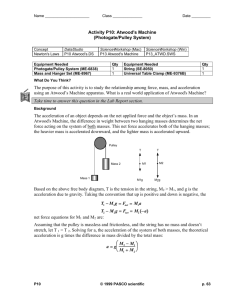Atwoods Machine
advertisement
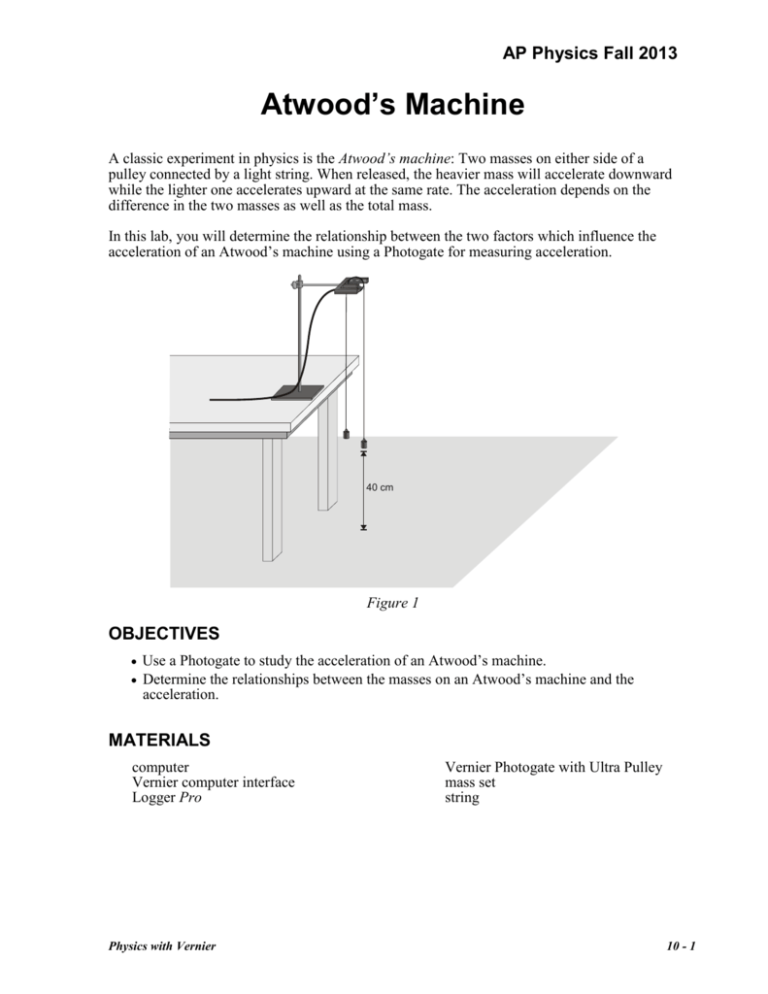
AP Physics Fall 2013 Atwood’s Machine A classic experiment in physics is the Atwood’s machine: Two masses on either side of a pulley connected by a light string. When released, the heavier mass will accelerate downward while the lighter one accelerates upward at the same rate. The acceleration depends on the difference in the two masses as well as the total mass. In this lab, you will determine the relationship between the two factors which influence the acceleration of an Atwood’s machine using a Photogate for measuring acceleration. 40 cm Figure 1 OBJECTIVES Use a Photogate to study the acceleration of an Atwood’s machine. Determine the relationships between the masses on an Atwood’s machine and the acceleration. MATERIALS computer Vernier computer interface Logger Pro Physics with Vernier Vernier Photogate with Ultra Pulley mass set string 10 - 1 Computer 10 PROCEDURE Part I Constant Total Mass For this part of the experiment you will keep the total mass used constant, but move weights from one side to the other. The difference in masses changes. 1. Set up the Atwood’s machine apparatus as shown in Figure 1. Be sure the heavier mass can move at least 40 cm before striking the floor. 2. Connect the Photogate with Super Pulley to DIG/SONIC 1 of the interface. 3. Login to the computer. Connect the LabQuest to the laptop. Then open the “LoggerPro” application. Then, using the open file button in LoggerPRo, open the file “10 Atwoods Machine” in the Physics with Vernier folder. A graph of velocity vs. time will be displayed. 4. Arrange a collection of masses totaling 100 g on m2 and a 100 g mass on m1. What is the acceleration of this combination? Record your values for mass and acceleration in the data table. 5. Move 5g from m2 to m1. Record the new masses in the data table. 6. Position m1 as high up as it can go. Click to begin data collection. Steady the masses so they are not swinging. Wait one second and release the masses. Catch the falling mass before it strikes the floor or the other mass strikes the pulley. 7. Click the Examine button and select the region of the graph where the velocity was increasing at a steady rate. Click the Linear Fit button to fit the line y = mt + b to the data. Record the slope, which is the acceleration, in the data table. 8. Continue to move masses from m2 to m1 in 5 g increments, changing the difference between the masses, but keeping the total constant. Repeat Steps 6–7 for each mass combination. Repeat this step until you get at least five different combinations. Part II Constant Total Difference For this part of the experiment you will keep the difference in mass between the two sides of the Atwood’s machine constant and increase the total mass. 9. Put 120 g on m1 and 100 g on m2. 10. Repeat Steps 6–7 to collect data and determine the acceleration. 11. Add mass in 20 g increments to both sides, keeping a constant difference of 20 grams. Record the resulting mass for each combination in the data table. Repeat Steps 6–7 for each combination. Repeat the procedure until you get at least five different combinations. 10 - 2 Physics with Vernier Atwood’s Machine DATA TABLE Part I: Total Mass Constant Trial m1 (g) m2 (g) Acceleration 2 (m/s ) m (g) mT (g) m (g) mT (g) 1 2 3 4 5 Part II: The Mass Difference Constant Trial m1 (g) m2 (g) Acceleration 2 (m/s ) 1 2 3 4 5 ANALYSIS 1. For each trial, calculate the difference between m1 and m2. Enter the result in the column labeled m. 2. For each trial, calculate the total mass in grams. Enter the result in the column labeled mT. 3. Create a graph of acceleration vs. m, using the Part I data. Based on your analysis of the graph, what is the relationship between the mass difference and the acceleration of an Atwood’s machine? 4. Create a graph of acceleration vs. total mass, using the Part II data. Based on your analysis of the graph, what is the relationship between total mass and the acceleration of an Atwood’s machine? 5. Develop a single expression for the acceleration of an Atwood’s machine, combining the results of the previous two steps in the analysis. 6. Draw a free body diagram of m1 and another free body diagram of m2. Using these diagrams, apply Newton’s second law to each mass. Assume that the tension is the same on each mass and that they have the same acceleration. From these two equations, find an expression for the acceleration of m1 in terms of m1, m2, and g. Compare the expression to your result in Step 5 of Analysis. Physics with Vernier 10 - 3 Computer 10 LAB REPORT Your lab report is due on Friday November 22, 2013. You will have to use the procedure and information that is available on the course website. You will turn in an individual written lab report with the following sections: title, purpose / objectives, apparatus, materials, procedure, data, analysis (CALCULATIONS and graphs go in this section), and a conclusion. You can use parts of this document as parts of your lab report, however this document IS NOT TO BE TURNED IN!!! It is an informational and data gathering tool only. You should have TWO accurate graphs of your data, a free body diagram, and all questions answered. 10 - 4 Physics with Vernier
